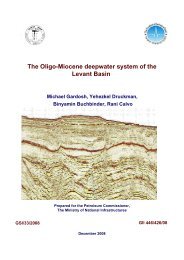tivity on the carmel faul
tivity on the carmel faul
tivity on the carmel faul
You also want an ePaper? Increase the reach of your titles
YUMPU automatically turns print PDFs into web optimized ePapers that Google loves.
case, it is not clear which of those two <strong>faul</strong>t systems caused damage to speleo<strong>the</strong>ms<br />
analyzed from Denya Cave.<br />
The sample age cluster at ca. 5ka from Denya Cave may correlate well to <strong>the</strong> seismic<br />
event which caused structural damage to <strong>the</strong> EB I temple at Megiddo (Marco et al., 2006)<br />
as well as to six damaged speleo<strong>the</strong>ms dated to that approximate time (4.9-5.7ka or older)<br />
at Soreq cave in <strong>the</strong> Judean Hills (Kagan, 2002).<br />
A seismic event at ca. 10ka is very clearly documented in Denya Cave speleoseismites<br />
but is too old to be observed in Megiddo, which has no archeological evidence<br />
from that period. That age might also be too young to be noted in paleoseismic trenches,<br />
which were dug al<strong>on</strong>g <strong>the</strong> CF in <strong>the</strong> Kish<strong>on</strong> Valley, since most of <strong>the</strong> upper layers in that<br />
area may have been disturbed by human ac<str<strong>on</strong>g>tivity</str<strong>on</strong>g> (Zilberman et al., 2006). This event was<br />
not recorded at all in Soreq Cave as well. It might have been recorded in two<br />
paleoseismic trenches in <strong>the</strong> area of Ein-Gev, al<strong>on</strong>g <strong>the</strong> nor<strong>the</strong>rn segment of <strong>the</strong> DST,<br />
which were dated to ca. 11ka (Amit et al., 2009).<br />
The seismic event recorded in Denya Cave speleo<strong>the</strong>ms at ca. 21ka might be<br />
supported by <strong>the</strong> age of <strong>the</strong> upper part of <strong>the</strong> shutter ridge dated by Zilberman et al.<br />
(2006) to 24.5±2.5ka, which was followed by an incisi<strong>on</strong> of <strong>the</strong> stream channel and<br />
assumed to be indicative of <strong>faul</strong>t movement.<br />
A seismic event at ca. 29ka, obtained from Denya Cave speleo<strong>the</strong>ms, might be<br />
supported by <strong>the</strong> ages obtained for a layer in a paleoseismic trench al<strong>on</strong>g <strong>the</strong> Nesher <strong>faul</strong>t,<br />
which indicates a terminati<strong>on</strong> of a 50ka l<strong>on</strong>g subsidence, dated to 27±1ka (Zilberman et al.,<br />
2006).<br />
The well c<strong>on</strong>strained age of ca. 38ka for a seismic event, which affected Denya Cave,<br />
could probably be supported by three different paleoseismic findings. The first, an event<br />
reported by Kagan et al. (2007) at ~39±1 ka, which has left evidence of brecciated marls at<br />
four Lake Lisan sites al<strong>on</strong>g <strong>the</strong> Dead Sea basin as well as five well-c<strong>on</strong>strained collapses in<br />
different areas of <strong>the</strong> Soreq cave. Ano<strong>the</strong>r <strong>on</strong>e is a stratigraphic step in a paleoseismic<br />
trench al<strong>on</strong>g <strong>the</strong> CF, which was dated to 32±4.4ka, and indicated that <strong>the</strong> <strong>faul</strong>ting occurred<br />
before ca. 35ka (Gluck, 2002). And <strong>the</strong> last is <strong>the</strong> dated layers to ca. 37ka in two<br />
paleoseismic trenches in Ein-Gev (Amit et al., 2009).<br />
The age cluster of ca. 58ka is based <strong>on</strong> pre-seismic event samples from Denya Cave,<br />
which indicates that a seismic event occurred sometime after. This age might possibly be<br />
supported by three collapses dated in Soreq cave speleo-seismites, and Lake Lisan<br />
brecciated marls at three sites, which all yielded an age of 52±2.<br />
73

















